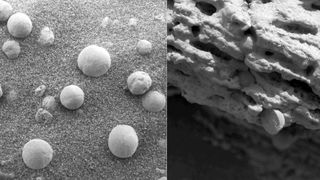Curiosity rover snaps close-up of tiny 'mineral flower' on Mars
The beautiful branching rock formed when water still covered the Red Planet.

NASA's Curiosity rover recently got up close and personal with a tiny, flower-like mineral deposit on the surface of Mars. The beautiful branching rock, which is just 0.4 inch (1 centimeter) wide, looks a bit like a coral or a sponge. Despite its likeness to a living organism, however, the deposit is not alive and is a fairly common sight across the Martian landscape.
Curiosity snapped a picture of the tiny mineral flower on Feb. 25 near Aeolis Mons, also known as Mount Sharp, at the heart of the 96-mile-wide (154 kilometers) Gale crater, which the rover has been studying since its arrival on the Red Planet in 2012. The image is a composite of multiple shots taken by Curiosity's Mars Hand Lens Imager, which takes close-ups using a magnifying lens. This type of composite photo allows the rover to produce much more detailed images, according to NASA.
The flower-like rock, which has been named the Blackthorn Salt, is a diagenetic feature, or one made from minerals that precipitated from ancient water that had previously been mixed with Martian rock, Abigail Fraeman, a planetary scientist and deputy project scientist for the Curiosity rover, told Live Science. Diagenetic features found on Mars are similar in size but can have either a branched shape, also known as dendritic form, like the Blackthorn Salt, or be more rounded or even spherical, like other rocks in the same photo, she added.
Related: 6 reasons astrobiologists are holding out hope for life on Mars
"We've seen diagenetic features with similar shapes before," Fraeman said, "but this dendritic shape is particularly beautiful."
Curiosity has uncovered several other diagenetic features since its arrival in Gale crater. That's not surprising given that the crater could once have been a lake that would have provided the water from which such features precipitate. In 2015, several other flower-like deposits were discovered in the Pahrump Hills area, and in 2019, other diagenetic features were found at the Murray formation.

And in 2004, Curiosity's older sibling, the Opportunity rover, found a number of spherical features on Meridiani Planum — a plain-like area near the Martian equator — with a bluish-silver hue, earning them the nickname "Martian blueberries." These rocks were blue because they were composed of hematite, a type of iron oxide, Fraeman said. The Blackthorn Salt and other features photographed by Curiosity have a composition and color almost identical to those of the surrounding bedrock, she added.
Get the Space.com Newsletter
Breaking space news, the latest updates on rocket launches, skywatching events and more!
Continuing to document new diagenetic features like the Blackthorn Salt is important because it could help researchers figure out when liquid water disappeared from Mars. "We can learn more about the complex and long-lived history of water at Mount Sharp," Fraeman said. This could reveal more information about how long the environment could have been potentially habitable to life, she added.
Originally published on Live Science.
Join our Space Forums to keep talking space on the latest missions, night sky and more! And if you have a news tip, correction or comment, let us know at: community@space.com.

Harry is a U.K.-based staff writer at Live Science. He studied Marine Biology at the University of Exeter (Penryn campus) and after graduating started his own blog site "Marine Madness," which he continues to run with other ocean enthusiasts. He is also interested in evolution, climate change, robots, space exploration, environmental conservation and anything that's been fossilized. When not at work he can be found watching sci-fi films, playing old Pokemon games or running (probably slower than he'd like).

